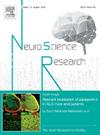Hindering tau fibrillization by disrupting transient precursor clusters
IF 2.3
4区 医学
Q3 NEUROSCIENCES
引用次数: 0
Abstract
Tau protein, a central player in Alzheimer’s disease (AD), exhibits cytotoxicity upon fibril formation. Understanding the early stages of tau fibrillization is therefore critical for the development of effective therapeutics. Previous work [Rasmussen. et. al, J. Mol. Biol., 2023] reported the rapid formation of Thioflavin T (ThT)-inactive clusters upon mixing tau with anionic polymers, yet the functional role of these clusters remained unclear. Here, we demonstrate that these transient clusters act as obligatory precursors in the fibrillization pathway. Using small-angle X-ray scattering (SAXS) and ThT fluorescence, we show that disrupting the clusters via NaCl addition hinders fibril formation, highlighting their reversible and targetable nature. This behavior is analogous to polymer crystallization, in which disordered chains undergo structural ordering through intermediate precursor states. We propose that similar physical principles underlie the aggregation of other intrinsically disordered proteins such as α-synuclein.
干扰瞬态前体簇阻碍Tau纤化。
Tau蛋白是阿尔茨海默病(AD)的核心参与者,在纤维形成时表现出细胞毒性。因此,了解tau纤维化的早期阶段对于开发有效的治疗方法至关重要。以前的工作[Rasmussen]。等。J. Mol.生物学。[j], 2023]报道了在将tau与阴离子聚合物混合后快速形成ThT -非活性簇,但这些簇的功能作用尚不清楚。在这里,我们证明了这些瞬态簇在成纤化途径中充当强制性前体。利用小角x射线散射(SAXS)和ThT荧光,我们发现通过NaCl加入破坏簇阻碍了原纤维的形成,突出了它们的可逆性和靶向性。这种行为类似于聚合物结晶,其中无序链通过中间前驱体状态进行结构排序。我们提出类似的物理原理是其他内在无序蛋白(如α-突触核蛋白)聚集的基础。
本文章由计算机程序翻译,如有差异,请以英文原文为准。
求助全文
约1分钟内获得全文
求助全文
来源期刊

Neuroscience Research
医学-神经科学
CiteScore
5.60
自引率
3.40%
发文量
136
审稿时长
28 days
期刊介绍:
The international journal publishing original full-length research articles, short communications, technical notes, and reviews on all aspects of neuroscience
Neuroscience Research is an international journal for high quality articles in all branches of neuroscience, from the molecular to the behavioral levels. The journal is published in collaboration with the Japan Neuroscience Society and is open to all contributors in the world.
 求助内容:
求助内容: 应助结果提醒方式:
应助结果提醒方式:


